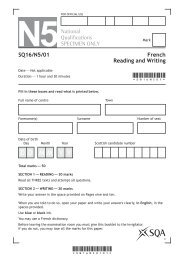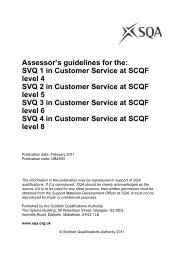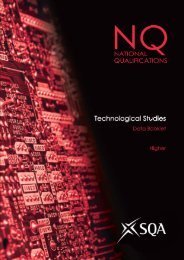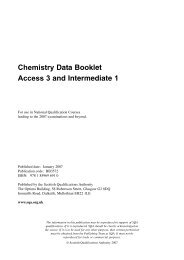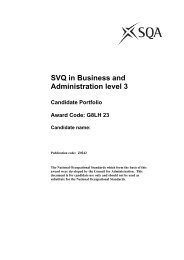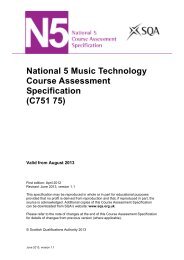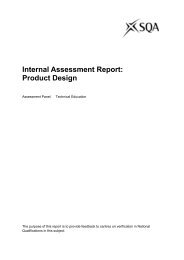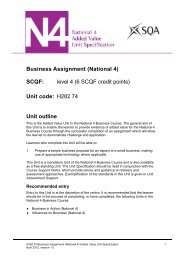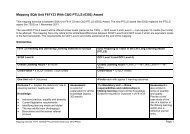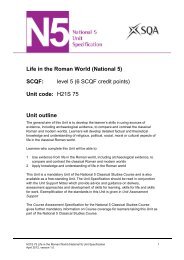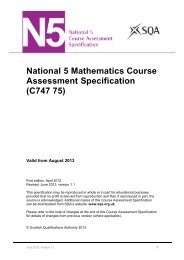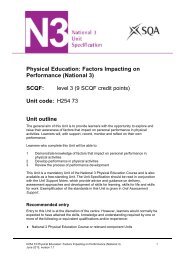Lifeskills Mathematics Test - Scottish Qualifications Authority
Lifeskills Mathematics Test - Scottish Qualifications Authority
Lifeskills Mathematics Test - Scottish Qualifications Authority
You also want an ePaper? Increase the reach of your titles
YUMPU automatically turns print PDFs into web optimized ePapers that Google loves.
Geometric Outcome<br />
The learner will use reasoning skills and geometric skills linked to straightforward<br />
real-life contexts<br />
Skills<br />
Explanation<br />
Determining the gradient of a slope Using ‘vertical height’ and ‘horizontal distance’<br />
Investigating a situation involving<br />
perimeter<br />
♦ rectilinear<br />
♦ circular<br />
♦ composite shape<br />
Investigating a situation involving area ♦ triangles<br />
♦ kite, rhombus, parallelogram<br />
♦ circle<br />
♦ composite shape<br />
Investigating a situation involving ♦ prism (including cuboid, cylinder)<br />
volume<br />
Solving a problem involving the use of<br />
Pythagoras’ theorem<br />
Using a scale factor on the<br />
dimensions of a shape<br />
Problems involving increase/decrease in an<br />
amount or measurement according to a scale<br />
factor<br />
Numeracy (National 4)<br />
Numerical Outcome<br />
The learner will use numerical skills to solve straightforward, real-life problems<br />
involving money/time/measurement<br />
Skills<br />
1.1 Selecting and using appropriate<br />
numerical notation and units<br />
1.2 Selecting and carrying out<br />
calculations<br />
Explanation<br />
Numerical notation should include: =, +, –, ×, /,<br />
÷, , ( ), %, colon and decimal point<br />
Units should include:<br />
— money (pounds and pence)<br />
— time (months, weeks, days, hours,<br />
minutes, seconds)<br />
— measurement of length (millimetre,<br />
centimetre, metre, kilometre, mile);<br />
weight (gram, kilogram); volume<br />
(millilitre, litre) and temperature<br />
(Celsius or Fahrenheit)<br />
♦ add and subtract whole numbers including<br />
negative numbers<br />
♦ multiply whole numbers of any size, with up<br />
to four-digit whole numbers<br />
♦ divide whole numbers of any size, by a single<br />
digit whole number or by 10 or 100<br />
♦ find whole number remainders<br />
♦ round answers to the nearest significant<br />
figure or two decimal places<br />
♦ find simple percentages and fractions of<br />
shapes and quantities, eg 50%, 10%, 20%<br />
and 25%, 33⅓%; ½, ⅓, ¼, 1/10, 1/5<br />
♦ calculate percentage increase and decrease<br />
♦ convert equivalences between common<br />
fractions, decimals and percentages<br />
H228 74 <strong>Lifeskills</strong> <strong>Mathematics</strong> <strong>Test</strong> (National 4) Added Value Unit Specification 9<br />
June 2013, version 1.1



